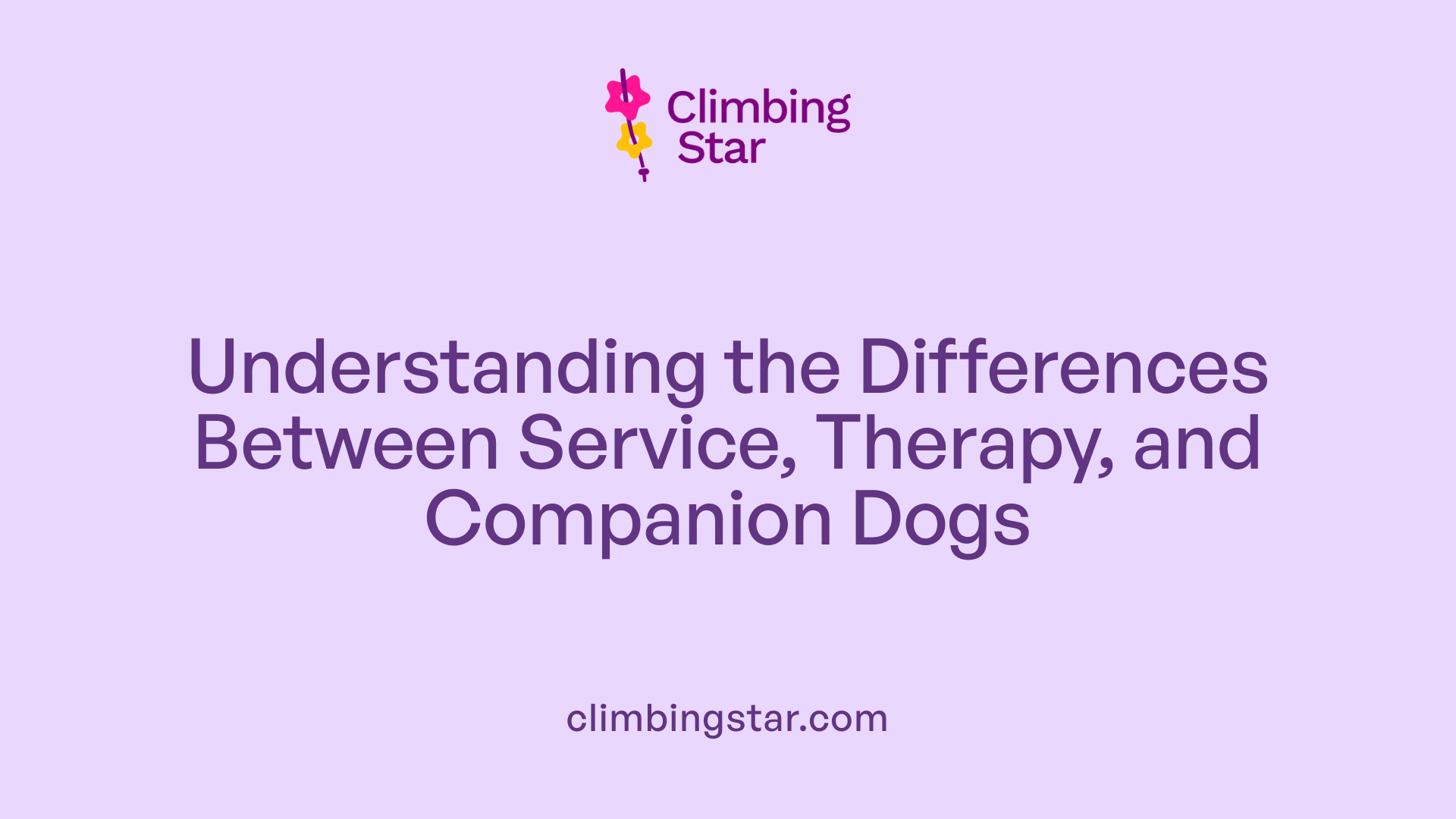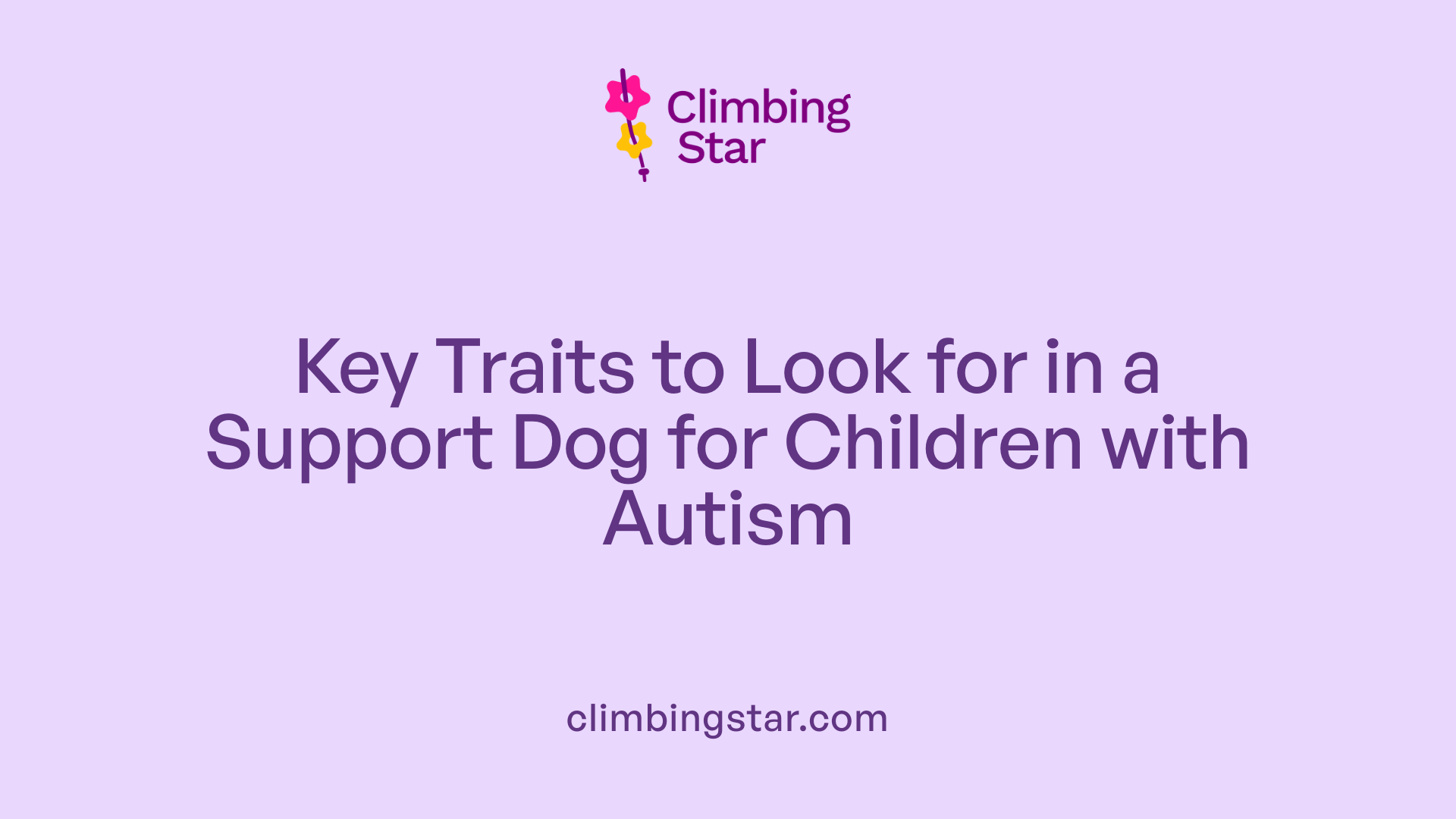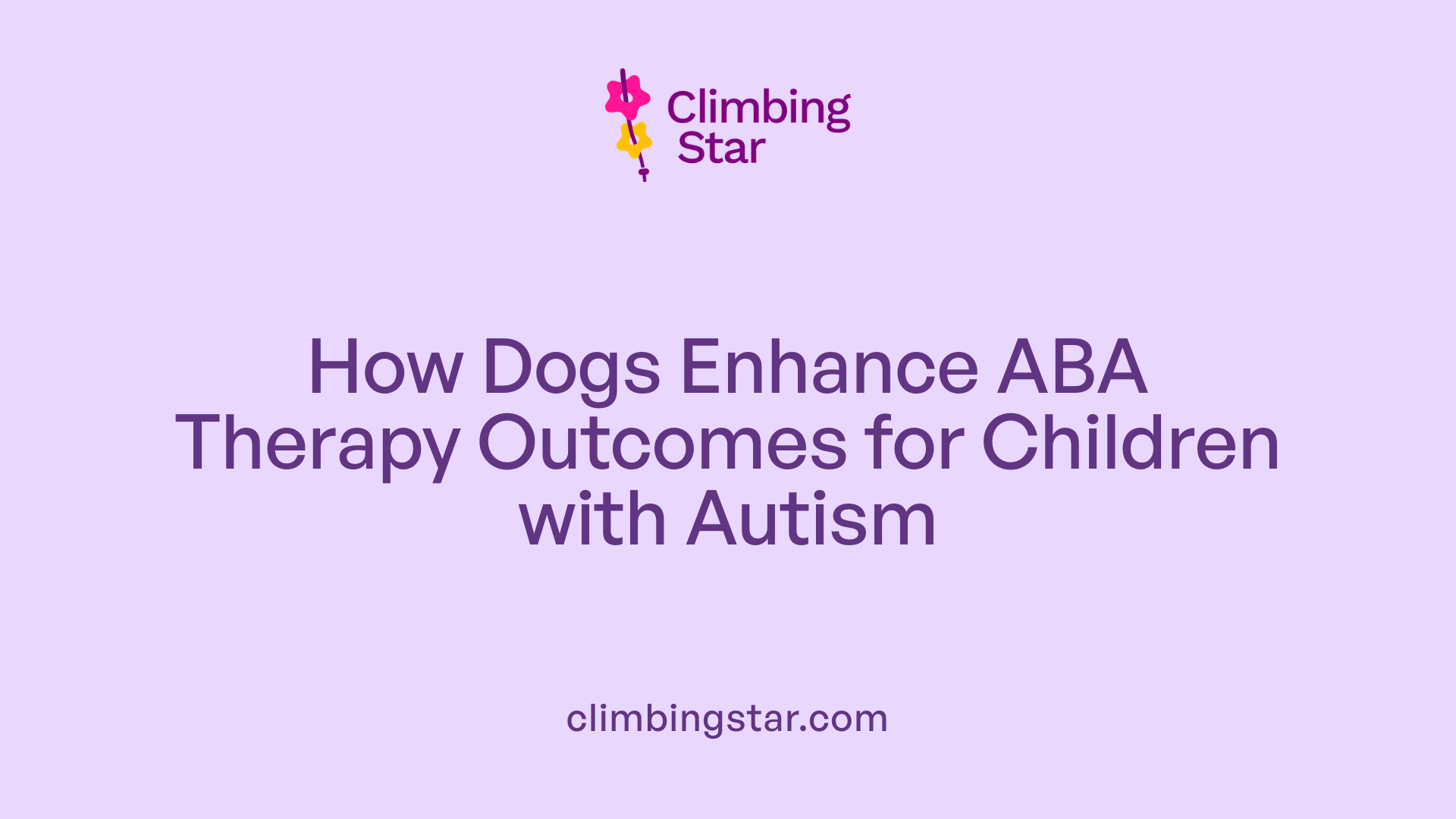Understanding the Role of Dogs in Autism Support
For children with autism spectrum disorder (ASD), dogs can offer more than companionship. They play powerful roles in improving emotional wellbeing, social engagement, and anxiety management. This article explores the types of dogs best suited for autistic children, their unique roles—ranging from highly trained service dogs to loving family pets—and how they complement therapies such as Applied Behavior Analysis (ABA). We delve into breed characteristics, training considerations, and how support dogs help children thrive in everyday life.
The Unique Benefits of Dogs for Children with Autism

How Do Dogs Help Children with Autism Learn Empathy?
Dogs provide a nonverbal, gentle way for children with autism to connect and engage. Their predictable and simple communication helps autistic children better understand emotions and responses, fostering empathy. By interacting with a dog, children can practice caring behaviors, which translates into improved social understanding and relationships.
How Do Dogs Reduce Anxiety and Help Manage Overwhelming Situations?
Children with autism often face anxiety and sensory overload. Dogs offer calming companionship that can soothe these feelings. Many service dogs are specially trained to recognize signs of anxiety or overstimulation and use comforting pressure or presence to help the child regain calm.
Why Does Dogs’ Simple and Consistent Communication Aid Engagement?
Dogs communicate in clear, consistent ways using body language and predictable behaviors. This straightforward style is easier for autistic children to read and respond to compared to complex human social cues. This clarity supports increased interaction and engagement.
In What Ways Do Dogs Lower Blood Pressure and Improve Mental Health?
Physical interaction with dogs—such as petting or playing—can lower blood pressure and reduce anxiety levels. This provides tangible mental health benefits, contributing to reduced stress for autistic children, who are often sensitive to overwhelming environmental stimuli.
Overall, the presence of a well-chosen dog offers children with autism consistent support, emotional connection, and mental health benefits that enrich their daily lives.
Distinguishing Service Dogs, Therapy Dogs, and Companion Pets

What are the differences between service dogs, therapy dogs, and pets for children with autism?
Service dogs, therapy dogs, and companion pets each play unique roles in supporting children with autism, differing notably in training, function, and legal status.
Service dogs undergo extensive, specialized training to perform tasks tailored to the individual’s needs. For children with autism, these dogs can recognize signs of anxiety or self-injurious behavior and respond with interventions like providing calming pressure. They assist during daily activities such as medical visits, shopping, or travel. Importantly, under the Americans with Disabilities Act (ADA), service dogs have public access rights, allowing them to accompany their handler in virtually all public spaces.
Therapy dogs, while also trained, primarily offer emotional support by visiting community settings such as schools, hospitals, nursing homes, and rehabilitation centers. Their role focuses on promoting calming effects and encouraging social interaction, but they do not possess the legal right to public access like service dogs.
Companion pets, often well-trained family animals such as golden retrievers or labradoodles, provide unconditional love, friendship, and an opportunity for social engagement. Though they lack specific task training and public access rights, these pets can foster responsibility, emotional comfort, and routine for children with autism.
Legal Rights and Public Access Under the ADA
The ADA permits individuals with disabilities to train their own service dogs and grants these animals broad public access. This includes places like restaurants, stores, and public transportation. Therapy dogs and companion pets, however, are generally restricted to private or controlled environments and do not enjoy such widespread access rights.
Functions of Autism Service Dogs
Autism service dogs perform critical functions that include recognizing triggers of distress, providing reassuring pressure to reduce anxiety, interrupting repetitive or harmful behaviors, and assisting in managing emotional meltdowns. Despite their supportive role, they are trained not to serve as babysitters and should not be left unattended tethered to children to maintain safety.
In summary, selecting the appropriate dog involves evaluating the child's specific needs, the dog's temperament, and family readiness, often with professional guidance to ensure the best match and training outcome.
Popular Dog Breeds Ideal for Supporting Children with Autism

Which dog breeds are best suited for children with autism and why?
Dogs chosen to support children with autism typically share certain temperamental traits, including calmness, intelligence, affection, and a strong eagerness to please. These qualities allow them to be easily trained and to respond appropriately to a child's emotional and sensory needs.
Breeds such as Golden Retrievers and Labrador Retrievers are renowned for their gentle nature and intelligence. They thrive on companionship and have a natural ability to provide emotional comfort and reduce anxiety, making them ideal autism support animals. Standard Poodles and Labradoodles combine high trainability with sociable, calm demeanors, adding to their suitability.
Larger breeds like Saint Bernards and German Shepherds also excel in support roles due to their protective instincts and loyalty, offering both safety and companionship. Newfoundlands and Great Pyrenees bring calmness and gentleness, beneficial in preventing overstimulation for sensitive children.
For families with limited living space or children who benefit from smaller dogs, breeds such as Cavalier King Charles Spaniels, Pugs, and Yorkshire Terriers are excellent choices. Their smaller size doesn't compromise their affectionate and social behavior, and they adapt well to therapy and emotional support roles.
In summary, selecting the right dog for autism support depends on temperament, intelligence, trainability, and the family environment. Calm, obedient, and affectionate breeds offer the best combination to help children with autism develop social skills, reduce anxiety, and foster empathy through consistent, loving interaction.
Understanding Autism Service Dogs and Their Specialized Training

How do autism service dogs assist children and what training is involved?
Autism service dogs are highly trained animals designed to support children with autism by recognizing specific behavioral cues that may indicate anxiety or self-injurious behaviors. These dogs are capable of detecting early signs of emotional distress and respond by applying calming pressure, such as leaning or nudging, which helps reduce anxiety and prevent emotional meltdowns.
Task-specific training tailored to individual needs
Each autism service dog undergoes specialized training that is tailored to the unique requirements of the child they assist. This training focuses on interrupting repetitive or harmful behaviors, providing emotional support during overwhelming situations, and helping the child feel secure in various settings like medical visits, shopping trips, or social environments. The task-specific training also includes developing a deep bond with the child to better interpret subtle signals.
Safety considerations: dogs are helpers, not babysitters
While autism service dogs provide essential support, it is important to understand that they are not substitutes for adult supervision. These dogs are trained helpers, not babysitters, and should not be tethered to children to ensure safety. Their role is to assist the child by promoting calmness and aiding social interaction, not to replace the responsibilities of caregivers.
Through intensive and focused training, autism service dogs become invaluable companions that improve the child’s quality of life by reducing anxiety, interrupting harmful behaviors, and providing comfort and support in challenging situations.
Therapy Dogs: Emotional Support in Community and Healthcare Settings

What roles do therapy dogs play for children with autism?
Therapy dogs offer vital emotional support in settings like schools, hospitals, and rehabilitation centers. They provide comfort and affection, helping children with autism spectrum disorder (ASD) to feel calmer and more socially engaged in environments that might otherwise feel overwhelming.
Unlike service dogs, therapy dogs are not trained for specific tasks to assist with disabilities. Instead, their primary role is to encourage positive interactions and soothe anxiety through their presence. This support can improve mood and promote social behaviors in children who may struggle with communication and sensory overload.
How are therapy dogs trained for comfort and calming interaction?
Training for therapy dogs focuses on behavior, hygiene, and social skills to ensure they safely provide affection and calm in public community settings. Agencies like Focus Care emphasize immunizations, cleanliness, and proper behavior standards for therapy dogs. These efforts ensure children with autism can interact with well-behaved animals, maximizing therapeutic benefits while minimizing risks.
The dogs are selected not only based on breed traits but also on their temperament and ability to remain calm in stressful environments. Popular breeds for therapy work include Labrador Retrievers, Golden Retrievers, Poodles, Beagles, and Cavalier King Charles Spaniels—dogs known for their gentle and friendly nature.
How do therapy dogs differ from service dogs in legal access and task specificity?
Therapy dogs do not have the same public access rights as service dogs under the Americans with Disabilities Act (ADA). They are limited to visiting community settings such as schools, hospitals, and nursing homes by invitation rather than being permitted in all public spaces.
Additionally, therapy dogs do not perform specific disability-related tasks such as interrupting self-injurious behaviors or reducing anxiety on demand like autism service dogs. Their support is more generalized, focusing on emotional comfort rather than targeted assistance.
This distinction guides families and professionals in choosing the appropriate type of canine assistance for a child's needs, balancing legal regulations, training requirements, and desired outcomes.
| Aspect | Therapy Dogs | Service Dogs | Companion Dogs |
|---|---|---|---|
| Primary Role | Provide emotional support in community settings | Perform specific tasks to assist disabilities | Offer companionship and calming presence |
| Training Focus | Behavior, hygiene, social interaction | Task training tailored to individual's needs | Basic obedience and social skills |
| Public Access Rights | Limited to invited community venues | Full public access rights under ADA | No public access rights |
| Suitable Breeds | Labs, Goldens, Poodles, Beagles, Cavalier King Charles Spaniels | Labs, Goldens, Saint Bernards, Newfoundlands | Labs, Goldens, Labradoodles |
The Role of Family Companion Dogs in Autism Support

Can family pets support children with autism?
With proper training, family pets such as golden retrievers, labrador retrievers, or labradoodles can play a valuable role in supporting children with autism. These dogs serve as calming companions, offering unconditional love and friendship that help reduce anxiety and overstimulation common in children with autism spectrum disorder (ASD).
Teaching responsibility and social skills through pet care
Caring for a family dog encourages children with autism to develop a routine and sense of responsibility. Feeding, grooming, and interacting with the dog foster opportunities for social interaction and learning empathy. This daily engagement promotes a structured environment that many children with ASD find comforting.
Complementing formal therapies with companionship and routine
While family companion dogs do not perform specific assistance tasks like service dogs, they provide essential emotional support that complements formal therapies. Their consistent presence can improve mood, reduce feelings of isolation, and enhance social confidence, offering children and their families a natural source of comfort and motivation.
Overall, well-trained family pets are an accessible and meaningful support for children with autism, helping nurture emotional wellbeing and teach valuable life skills.
Key Characteristics to Consider When Choosing a Dog for Autism Support

How should families choose the right dog for a child with autism?
Choosing a suitable dog for a child with autism requires careful consideration of several factors to ensure the dog meets the child's unique needs. First and foremost, the dog's temperament and behavior should align with the child's personality and sensory sensitivities. Ideal dogs for autism support are typically calm, gentle, and affectionate, with a consistent and predictable communication style.
Training is another crucial aspect; dogs that have undergone specialized training—whether as service or therapy dogs—are better equipped to support children with autism by responding appropriately to anxiety, sensory overload, or self-injurious behaviors. Families often find it beneficial to consult with accredited agencies or professional trainers who specialize in matching dogs to individuals with autism.
Beyond the dog's qualities, family readiness and the child's preferences play vital roles. The family must be prepared to commit to the dog's care, training reinforcement, and creating a supportive environment. Meanwhile, involving the child in the selection process helps ensure a stronger bond and greater comfort with the animal.
Additional Considerations
- Seek professional evaluation to tailor the dog’s temperament and training to the child’s developmental and emotional needs.
- Consider the living environment and daily routines to select a dog breed and personality compatible with the household.
- Patience is essential as the process of selecting and training an appropriate support dog can take up to two years.
By thoughtfully assessing these elements, families can find a dog that not only provides companionship but also enriches the child's social skills, emotional support, and overall quality of life.
The Process of Selecting and Training Autism Support Dogs

What steps are involved in selecting and training a dog for autism support?
Selecting and training a dog to support a child with autism is a detailed and time-intensive process that can take up to two years to complete.
First, thorough assessments are conducted to understand the specific needs of the child and the family environment. This stage often includes home visits by trainers and professionals to observe daily routines and identify how a dog could provide the most effective support.
Once a suitable dog is identified, specialized training tailored to the child's needs begins. This training focuses on tasks such as recognizing signs of anxiety or self-injurious behavior and providing calming pressure or emotional support. It is essential that the dog is able to perform these functions reliably in various settings without causing distractions.
Collaboration between families, trainers, and professionals
Success in this process depends on collaboration among the child's family, professional trainers, and sometimes professionals such as occupational therapists. Families provide insight into the child's day-to-day experiences and preferences, which help trainers customize the dog's training.
This team approach ensures that the dog meets not only behavioral requirements but also fits well with the family’s lifestyle and the child's comfort levels.
Patience and consistency as essential factors for success
Training autism support dogs demands considerable patience and consistency. Families must be prepared to engage in ongoing reinforcement exercises with the dog to maintain its skills and ensure safety.
Consistency in routines between trainers and family members helps the dog learn effectively and adapt to the child's evolving needs. This continuous effort is crucial to building a strong, supportive bond between the dog and child, maximizing the therapeutic benefits of the partnership.
How Dogs Complement Applied Behavior Analysis (ABA) Therapy for Autism

What is ABA therapy and how do dogs complement it for children with autism?
Applied Behavior Analysis (ABA) therapy is a scientific approach designed to increase positive behaviors while reducing challenging ones, primarily through reinforcement strategies and detailed behavior analysis. This therapy focuses on developing communication, social skills, and behavioral regulation in children with autism. Dogs play an important complementary role by offering steady emotional support that can enhance a child’s receptiveness to ABA interventions.
Dogs, with their consistent and simple communication style, help create a calming environment that reduces anxiety and sensory overload—common challenges for children on the autism spectrum. This calming influence can make it easier for children to engage more fully in ABA sessions.
How dogs support ABA outcomes by improving social skills and emotional regulation
Interacting with dogs encourages social interaction and nurtures empathy. These interaction opportunities are valuable in reinforcing the communication and social skills targeted during ABA therapy. For instance, the presence of a therapy or companion dog promotes turn-taking, eye contact, and non-verbal communication—skills often emphasized in ABA programs.
Additionally, many service dogs trained for children with autism can detect signs of emotional distress or potential behavioral meltdowns and respond with comforting pressure or distraction techniques. This active emotional regulation support complements ABA’s goal of helping children manage their emotions and behaviors effectively.
Enhancing behavioral interventions with consistent companionship and calming influence
The stable companionship of a family pet or a trained assistance dog provides a predictable and safe presence that encourages children to practice new skills in real-life contexts. Caring for a dog also establishes structure and routine, which can offer comfort and reduce anxiety.
This ongoing, gentle support enhances the effects of ABA therapy by extending therapeutic benefits beyond sessions into everyday life. The dog’s calming presence acts as a natural stress buffer during overwhelming situations, promoting a more positive behavioral environment and facilitating generalization of ABA-developed skills.
In summary, dogs support ABA therapy by improving emotional regulation, fostering social engagement, and providing consistent companionship that bolsters the therapeutic process for children with autism.
Professional Providers and Qualifications in ABA Therapy

Who Provides ABA Therapy and What Qualifications Do These Professionals Have?
ABA therapy is delivered by a team of certified specialists dedicated to supporting individuals with autism spectrum disorder (ASD). The primary professionals involved include Board Certified Behavior Analysts (BCBAs), Registered Behavior Technicians (RBTs), and Assistant Behavior Analysts.
BCBAs are highly trained practitioners holding at least a master's degree in behavior analysis or a related field. They must also pass a comprehensive certification exam administered by the Behavior Analyst Certification Board (BACB). Their role encompasses conducting thorough assessments, designing tailored behavior intervention plans, and overseeing therapy sessions to ensure effective implementation.
RBTs are paraprofessionals who complete a specialized 40-hour training course and pass a certification exam. They provide one-on-one ABA services under the supervision of BCBAs, directly working with individuals to carry out specific therapy protocols.
Assistant Behavior Analysts often have additional experience or education and support BCBAs by contributing to data collection, analysis, and sometimes participating in intervention planning under supervision.
Training and Certification Requirements
Each role requires standardized training, practical experience, and certification to ensure quality and consistency in ABA services. BCBA certification demands graduate coursework in behavior analysis and supervised fieldwork hours. RBTs must complete training and competency assessments, with ongoing supervision essential to maintain their certification.
Collaboration with Families and Other Support Systems
ABA professionals work closely with families, educators, and other healthcare providers to create a cohesive support network. They involve caregivers in the therapy process, providing training and resources to promote skill generalization beyond clinical settings. This collaborative approach ensures interventions are personalized and effective, fostering optimal developmental outcomes for children with ASD.
Models of ABA Therapy and the Integration of Support Dogs

In-clinic, at-home, and parent-mediated ABA approaches
Applied Behavior Analysis (ABA) therapy for children with autism is delivered through multiple models to best suit individual needs. In-clinic ABA offers structured sessions within a professional setting, providing direct supervision by therapists. At-home ABA brings therapy into a familiar environment, promoting generalization of skills in daily life. Parent-mediated ABA empowers family members by training them to implement strategies, reinforcing learning and behavior management throughout routines.
Role of specialized companies in delivering ABA services
Specialized companies deliver ABA therapy by tailoring plans to each child's unique challenges and strengths. They utilize evidence-based interventions and coordinate across settings to ensure continuity of care. These organizations also provide ongoing training and support to families, enhancing skills that promote independence and adaptive functioning in diverse environments.
How therapy and service dogs can be incorporated to complement these models
Support animals—such as therapy and service dogs—can be integrated into ABA therapy to provide emotional and behavioral benefits. Their calming presence helps reduce anxiety and supports emotional regulation during sessions. Service dogs trained to recognize and interrupt self-injurious behaviors can be valuable in both clinical and home settings, complementing therapeutic goals.
Therapy dogs, meanwhile, foster social engagement and motivation, which can ease communication challenges seen in autism. Their inclusion can promote empathetic skills and encourage positive social interactions. Whether in structured clinics or informal at-home settings, these animals enhance the therapeutic environment by offering companionship and comfort.
Providers usually recommend collaboration with accredited dog training agencies to ensure that animals meet safety and behavioral standards appropriate for children with autism. Such partnerships help maximize the effectiveness of ABA therapy by addressing both behavioral and emotional needs comprehensively.
Choosing the Right Support Dog: A Pathway to Enhanced Autism Care
Dogs hold a remarkable capacity to support children with autism, providing emotional stability, encouraging social interaction, and complementing therapies like ABA. From highly trained service dogs that assist in managing specific behaviors to therapy and companion dogs offering comfort and friendship, the spectrum of canine support is broad and impactful. Careful selection, rigorous training, and professional guidance are essential to ensure the dog matches the child’s unique needs. With patience and collaboration between families, trainers, and therapists, the right dog can become an invaluable partner on the journey toward improved quality of life for children with autism.
References
- The Best Dogs for Autistic Children: Choosing the Right ...
- Service dogs or therapy dogs for autism
- The 10 Best Dog Breeds for Pet Therapy
- The 14 Best Dogs for Kids with Autism, According to Experts
- A Comprehensive Guide to ABA Therapist Requirements
- Applied Behavior Analysis (ABA)
- Who Qualifies for ABA Therapy: Eligibility Guide
- Applied Behavior Analysis (ABA)







